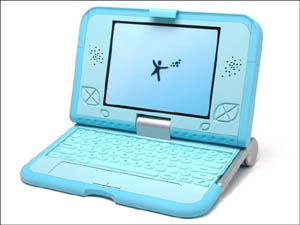 In 2002, theorganization known as “One Laptop Per Child” set out to do what many thought was impossible or impractical: build a mass-production laptop with a price tag under $100 thatis incredibly durable,can surf the web,and even run without electrical outlets via a hand-crank power supply.
In 2002, theorganization known as “One Laptop Per Child” set out to do what many thought was impossible or impractical: build a mass-production laptop with a price tag under $100 thatis incredibly durable,can surf the web,and even run without electrical outlets via a hand-crank power supply.
The concept is targeted at emerging markets (think Sudan), or just about any school system on planet earth that wants an extremely flexible, durable, low cost computing solution.
Nicholas Negroponte, chairman of One Laptop Per Child, said in a keynote at LinuxWorld here that OLPC is preparing to deliver its first 5 million to 10 million machines late this year or early in 2007. The machines will come with 7-inch screens and a 500MHz processor from Advanced Micro Devices, will use flash memory in lieu of a hard drive, and will run a Linux operating system.
By using a stripped-down version of Linux and older but still powerful microprocessors,the machinewill use less than 2 watts of electricity, compared with 40 watts for the typical laptop. That means the computer can be powered by a hand crank or foot pedal attached to its power adapter, which can also be plugged into a wall socket when electricity is available.
Each laptop contains a Wi-Fi wireless networking chip that would automatically link the machine to every other laptop in range. Thus users could communicate with one another over long distances, by bouncing the messages from machine to machine (think Napster).
Each laptop’s networking chip would continue to operate for up to 24 hours on battery power, even when the rest of the computer was shut down.
The laptop will feature a dual-mode screen. During daylight, it would have a high-resolution black-and-white screen; at night, when many poor families live in darkness, the laptop would display low-resolution color images, with a backlight for illumination.
My idealist sensibililties find this concept to be absolutely revolutionary, not just from the standpoint of charity, but as a brilliliant example of “design revolution” in the sense of Buckminster Fuller. Here we have a web-appliance that can operate on human power, and is capable of instantly creating a peer-to-peer wireless network when in the presence of other machines, at an absurdly cheap mass-production cost of $50 (the company marks it up to $100).
But what is most intriguing about this little gem is what it doesn’t have: bloat. The company has faced criticism from the Windows camp that the streamlinedLinux Os won’t allow users to load ubiquitous PC applications, or the massive MS Office applications that dominate the world of word processing, spreadsheets, and beyond. However, this is machine’s greatest asset.
The windows operating system would have made the low price impossible, especially if it was expected to run the upcoming Vista OS, which contains 80% more code than the already absurdly overweight XP Os. This highlights two major trends in the world of information systems today: One trend is to build bigger, faster machines that can run bigger andbulkier operating systems and applications; the other movement is to build smaller, faster, web-based code that can run on anyinternet capablemachine with a modern browser. The latter movement is commonly referred to as Web 2.0.
Web 2.0 generally refers to a second generation of services available on the World Wide Web that lets people collaborate, and share information online. In contrast to the first generation, Web 2.0 gives users an experience closer to desktop applications than the traditional static Web pages.
In fact, most computer users are already deeply rooted in the realm of Web 2.0. Your average person ignores desktop applications altogether in favor of using web-based internet portals like Hotmail or Gmail to do just about everything from mail to word processing, to data storage. Larger organizations often opt to build intranet applications that run off of a central server for accounting, collaboration, and beyond.
In the world of word processing, the days of MS Word’s domination of general document production are numbered. While Microsoft is gearing up to provide online versions of word that work through your browser and allow you to keep your documents online, Google has one-upped them by recently acquiring “Writely,” the small silicon valley upstart that already has a fully functional online word processing/ collaboration / document storage suite that can open, edit, and publish all popular document formats.
This will soon be incorporated into Gmail, the greatest free email service in history with over 2 gigabytes of free centralized storage for every user.
So clearly, the $100 laptop doesn’t seem so puny after all. Especially when you consider the meta-trends of your average user. Having a free laptop in the hands of every child also means that this human being is going to be exposed to the global community, have access to the biggest library in history, and the ability to communicate with everyone…
…even if they have to crank the handle to boot it up. God forbid they get some exercise.